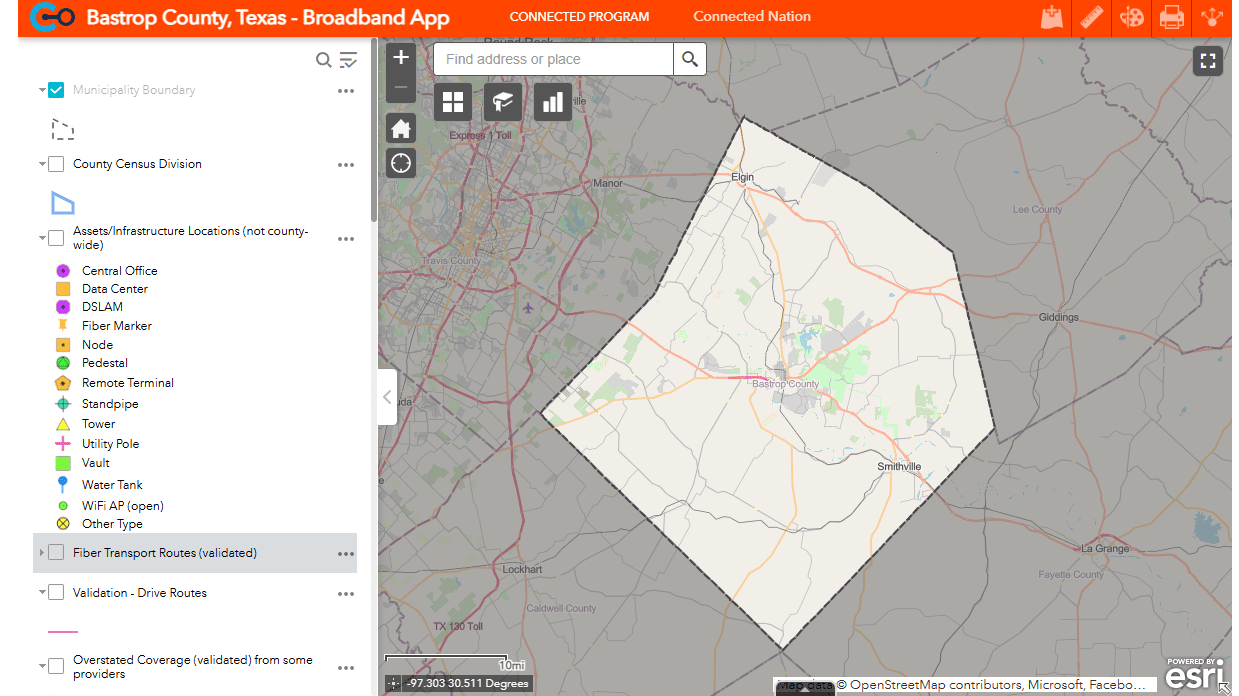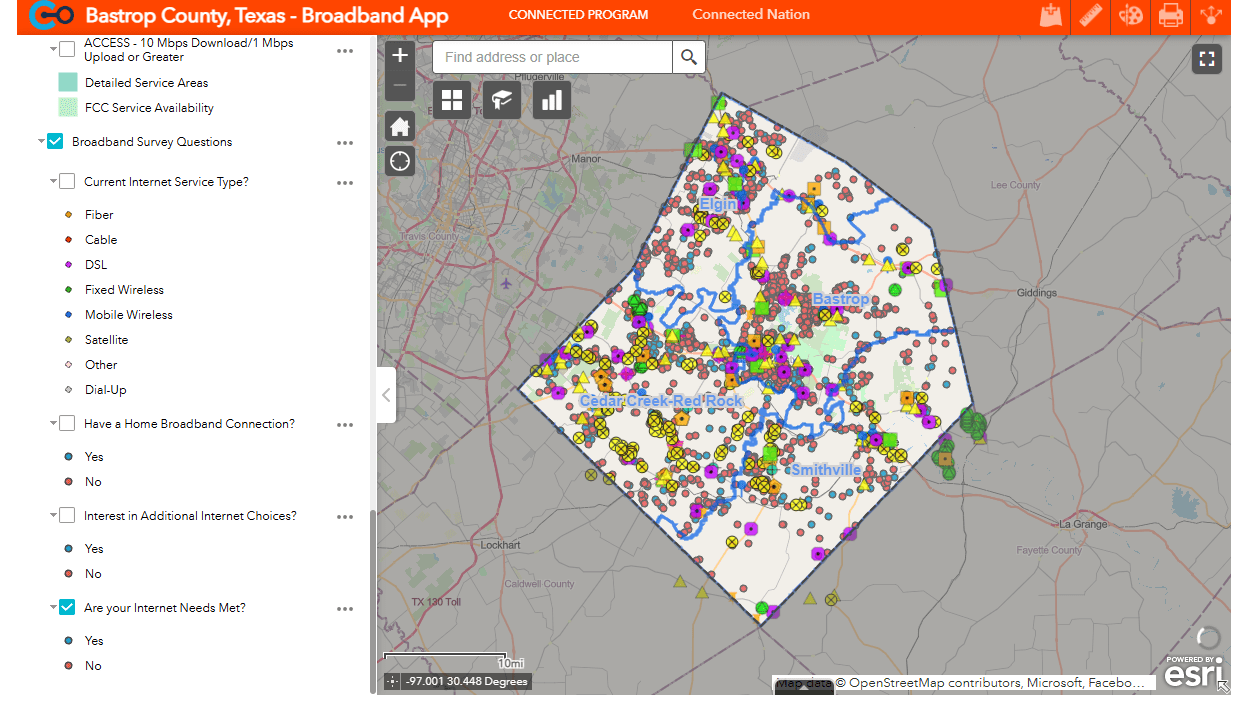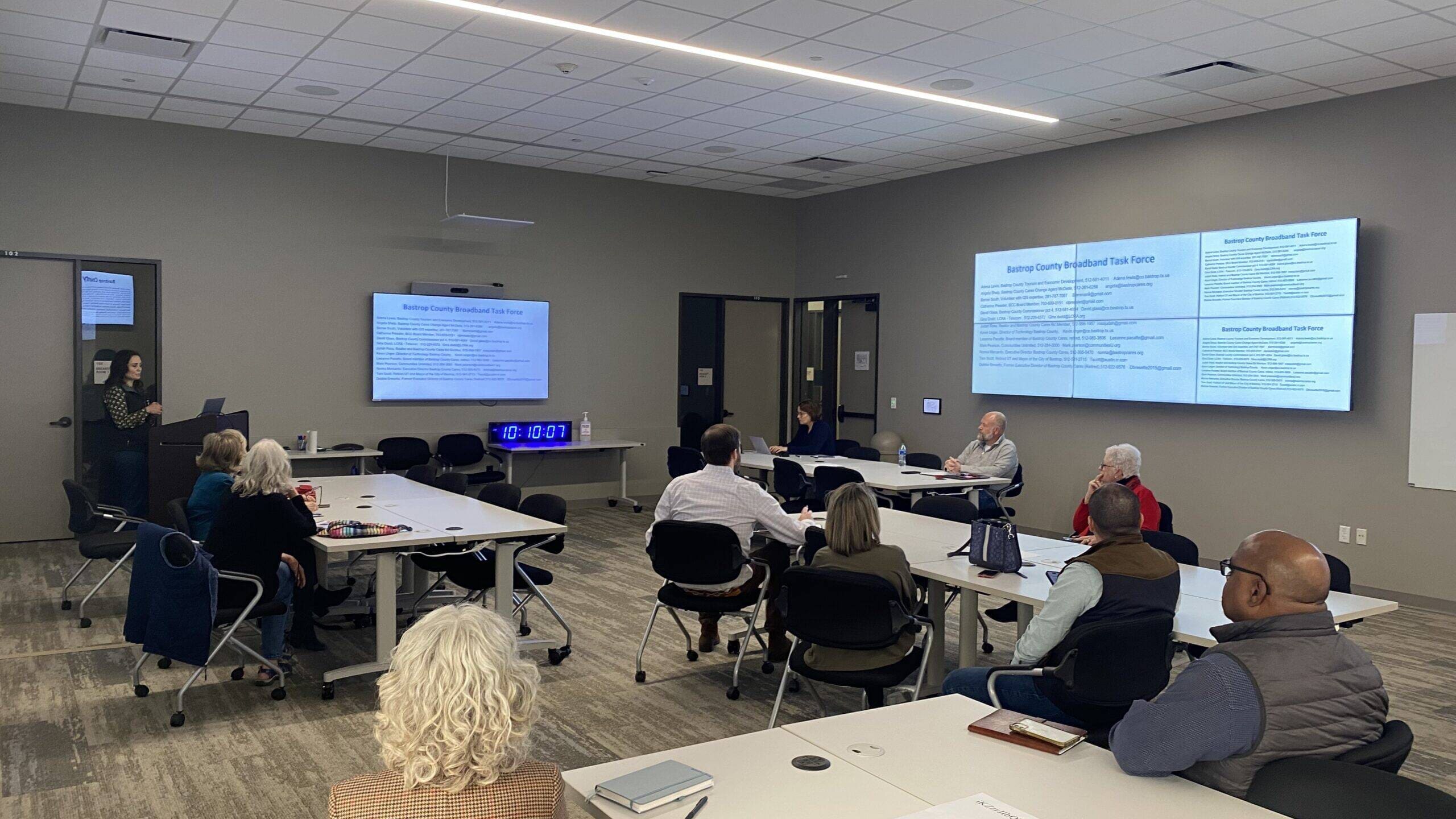Bastrop County, Texas, a vibrant yet largely rural region located in Central Texas just southeast of Austin, has long faced significant challenges with internet access. Known for its pine forests, rolling hills, and the Colorado River running through it, Bastrop County is a blend of small towns — including the county seat of Bastrop then Smithville, McDade, Elgin, and other unincorporated areas — and rural expanses that have historically struggled with connectivity due to their dispersed population and terrain.
The digital divide limited access to education, telehealth, and economic growth opportunities for many residents. But thanks to a committed group of local leaders, nonprofit organizations, strategic partnerships, and a scrappy, volunteer-driven broadband taskforce, Bastrop County is now poised to receive $47 million in funding through Bringing Online Opportunities to Texas (BOOT II) program. This funding will connect 10,471 locations through fiber-to-the-home (FTTH) technology.
The journey to secure high-speed broadband in Bastrop County began years ago, well before the COVID-19 pandemic exposed the urgency of reliable internet. As early as 2018, Adena Lewis, Director of Tourism and Economic Development for Bastrop County, started bringing key stakeholders together to address the county’s broadband challenges.
“It felt overwhelming, like eating an elephant one bite at a time, because broadband is expensive, and getting private companies to invest in areas without growth is tough. We first contracted with Connected Nation, which helped us map out where our broadband needs were. This allowed us to approach the issue more logically.”
— Adena Lewis, Director of Tourism & Economic Development, Bastrop County
The COVID-19 pandemic proved to be a turning point. Schools shut down, and the lack of internet access left many students unable to attend virtual classes. Telehealth services became critical, but residents in rural areas struggled to access them. Debbie Bresette, former Executive Director of Bastrop County Cares (BCC), recognized the opportunity to make broadband a public health priority.
“I called St. David’s Foundation and talked to the program officer, Abena Asante. I said, ‘Is there any way we could begin working on increasing broadband for Bastrop County?’” Bresette recalled. “They gave us $40,000, and we connected with Connected Nation.”
The Bastrop County Broadband Taskforce conducted a survey and received approximately 4,700 responses — far exceeding the typical response rate for a project. Added Lewis, “This showed how deeply our community wanted broadband. It also revealed that the gaps in coverage were much larger than what the FCC (Federal Communications Commission) maps had shown.”
This rich dataset allowed the team to visualize gaps in broadband access. The taskforce then worked to target messages to those more rural areas using census data. Bernie South, a retired Exxon geologist and volunteer Geographic Information Systems (GIS) specialist, mapped areas with significant connectivity issues, residential density, and topography, including homes underwater, census tracts, schoolchildren without internet, and areas where fiber had burned. Much of the fiber damage traced back to Hurricane Harvey, and mapping efforts revealed thousands of homes with limited or no access to reliable internet.
“We produced a lot of maps that were pretty definitive of Bastrop County and where the need was,” South said. “From that map, you could see the deficits and the numbers of people affected. It became the benchmark that we used.”
In McDade, the team worked to identify critical infrastructure and initiated connections using available towers, highlighting their problem-solving approach.
The backbone of Bastrop County’s success lies in its scrappy, community-driven broadband team — a diverse group of dedicated individuals who contributed their time and expertise to make this initiative possible. The team included Lewis, Bresette, and South, along with current BCC Executive Director Norma Mercado and volunteers like Catherine Pressler, Leeanne Pacatte, Commissioner David Glass, GIS intern Kirsten Kampmeier, and Gina Dodd with the Lower Colorado River Authority (LCRA).
“We are very action-oriented,” Mercado said. “Every meeting is about where we are, what needs to be done, and who is responsible. We don’t meet just to meet — there is always a clear purpose and action plan.”
This collaborative team tackled problems head-on, often finding innovative solutions through persistence.
“We weren’t discouraged by much,” South said. “We approached everything with data and let the data lead the way.”
As the data painted a clear picture of the county’s broadband challenges, the Bastrop County Broadband Taskforce grew, bringing in a new partner. Communities Unlimited (CU) joined the effort two years ago, providing technical assistance. Broadband Coordinator Mark Pearson from CU collaborated with the team to refine data, meet with internet service providers (ISPs), and navigate the complexities of state and federal funding programs. One of CU’s key contributions was facilitating collaboration between the broadband team and ISPs, ensuring they had the data necessary to apply for state grants.
“Mark from Communities Unlimited was a key figure. He helped us interpret complex broadband details and made sure we stayed on track. He and Bernie were invaluable to our progress.”
— Adena Lewis
These efforts paid off when Bastrop County was selected as one of 24 counties eligible for BOOT II funding. The BOOT program is administered by the Texas Comptroller’s office, with grants distributed through the Texas Broadband Office — a perfect fit for the large-scale efforts underway in Bastrop County. In January 2025, the Texas Broadband Development Office announced that Bastrop County would receive $47 million through the BOOT II program. With additional contributions from ISP Rural Telecommunications of America (RTA), the county’s total funding will reach more than $55 million.
“The excitement level is beyond excitement. It shows what a small group of community people can do when they come together and do what’s best for the entire community. We’re a scrappy group that changed the future of Bastrop County. I believe this is some of the most important work ever done here.”
— Debbie Bresette, Former Executive Director, Bastrop County Cares
The benefits of this investment are vast.
“It will allow all children, regardless of background, to have opportunities for success,” Bresette said. “Seniors and people with disabilities can access telehealth without needing transportation. It provides education and workforce training, supports school access, and creates an economic boom by building infrastructure so everyone can thrive — not just those with resources.”
RTA, with an office location in Smithville, is leading the installation of all fiber lines, poles, and necessary infrastructure. They will be tasked with laying 1,000 miles of fiber and 20,000 pole attachments, reaching all of the locations. Lewis said RTA’s proximity and deep understanding of local needs make them an ideal partner for this project. She added that the grant money must be spent, and everything must be connected by December 2026.
“Our private partner, RTA, is committed to meeting that deadline, and we’re confident in their ability to deliver,” Lewis said.
While broadband infrastructure is essential, ensuring that residents can fully benefit from improved connectivity requires a strong focus on digital literacy. Although not directly involved in the classes, this initiative aligns with CU’s broader mission to build community capacity.
With a $150,000 grant from Methodist Healthcare Ministries (MHM), BCC launched digital literacy classes at six locations across the county. The program, led by four digital connectors in partnership with Connected Nation, has already made an impact by equipping residents with the knowledge and tools needed to succeed in an increasingly digital world.
“Participants received a device — whether it was a computer, laptop, or smartphone — and we quickly saw the impact,” Mercado said. “Families gained access to better job opportunities, and students who previously couldn’t attend virtual classes were finally able to do so.”
The program has been particularly beneficial for seniors and people with disabilities, who now have the skills to access telehealth services from the comfort of their homes. For many, this has eliminated the need for long and costly trips to healthcare providers.
Mercado highlighted the importance of continued funding to expand digital education and prepare the community for safe and effective internet use.
“As this funding comes in, we want to ensure our residents are not only connected but also informed about internet safety and capable of using online resources to access education, telehealth, and job opportunities,” she said.
The involvement of Commissioner Glass and LCRA representative Dodd strengthened the team’s reach and credibility, Mercado stressed. The county’s ability to unite public and private sectors under a common goal exemplifies the power of collective action.
Bastrop County’s broadband journey is not just a local success story — it’s a model for other communities seeking to close the digital divide in rural America.
“The county was committed to solving the problem, but we didn’t want to be in the broadband business by ourselves. By teaming up with private partners and leveraging state and federal funding, we found a path forward. I believe this model could be replicated elsewhere. No single entity — whether the county, volunteers, or grant funders — could have done this alone. The combination of community dedication, public-private partnerships, and external funding made this dream possible. It’s a model of collaboration that should inspire other rural communities facing similar broadband challenges.”
— Adena Lewis
As the county celebrated the BOOT II funding announcement on February 10, it’s clear that their scrappy, data-driven, and community-led approach has set the stage for lasting change. Bastrop County is now positioned to bridge the digital divide and create economic impact in its communities.
“Working with the Bastrop County Team over the past two years has been a true joy,” Pearson said. “We knew better connectivity was needed, but the county couldn’t build or provide internet service. So, we encouraged local ISPs to seek funding and used GIS and FCC maps to show the need. My favorite part has been learning from the dedicated volunteers, especially the retirees with so much wisdom to offer.”





